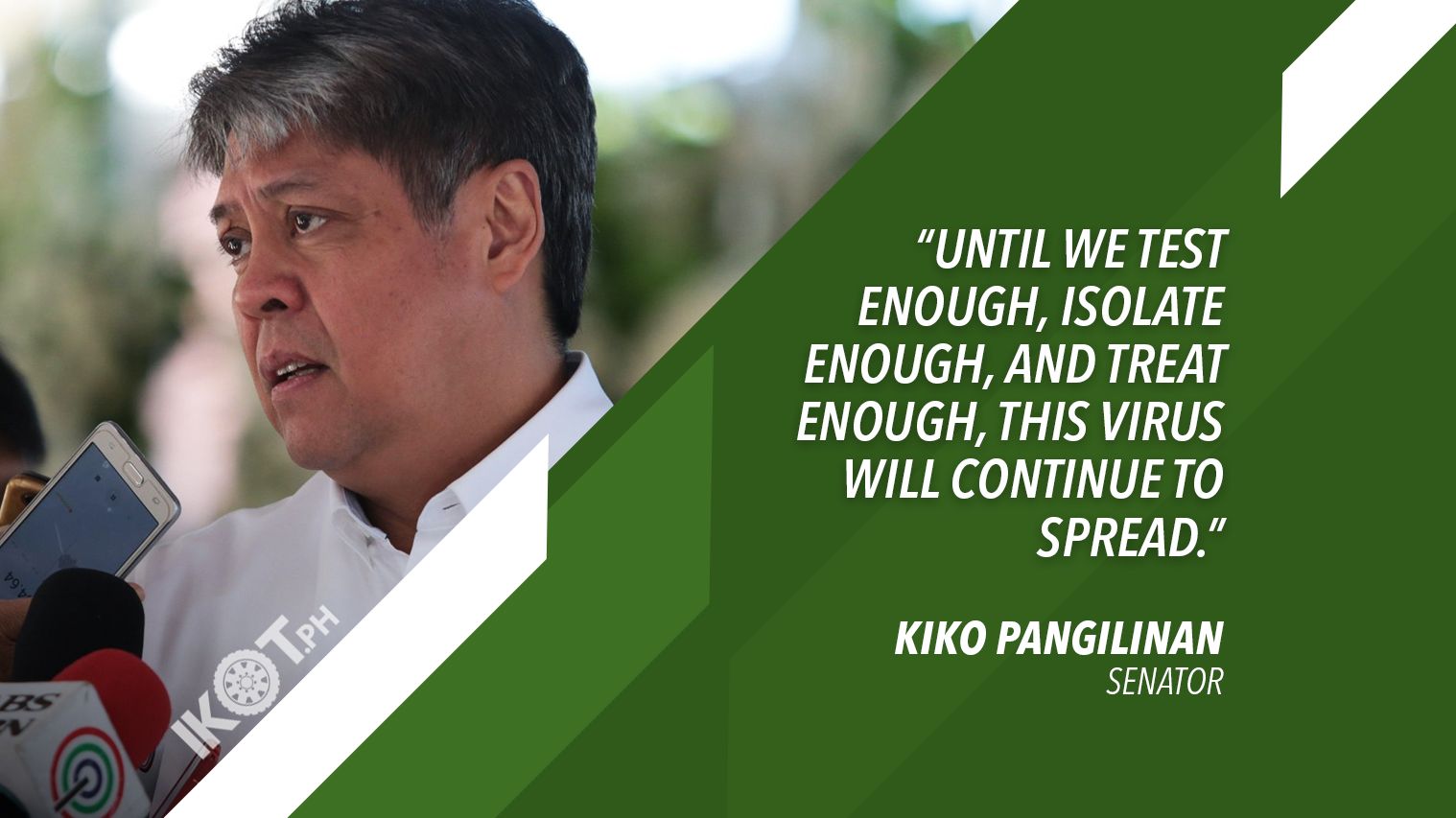Senator Kiko Pangilinan is questioning the pronouncement of the Department of Health that the country has “flattened the curve” and is now on the “second wave” of the coronavirus disease (COVID-19) pandemic.
“Can you please explain to us how can we say that we already flattened the curve when we have not tested enough? Until we test enough, isolate enough, and treat enough, this virus will continue to spread… Ano ‘yung ibig sabihin nung ‘we have flattened the curve and we are now experiencing a second wave?'” Pangilinan asked.
The veteran legislator directed his questions to Health Secretary Francisco Duque on the second day of the Senate Committee of the Whole hearing with various government agencies tasked to manage the effects of the pandemic.
“Na-flatten na raw yung curve sabi ni Secretary kahapon. At ngayon namang hapon ay ang binabanggit ni Secretary Duque ay second wave na pala itong nangyayaring infection. Kataka-taka ito dahil ang alam ko, base doon sa description kahapon o definition ng flattening of the curve ay wala na o bumabagsak na ‘yung new cases,” the seasoned lawmaker pointed out.
“Sana po ay mapaliwanag ni Secretary Duque kung ano ang ibig sabihin ng second wave dahil maliwanag kahapon pa lamang na wala pang 0.2% ang ating mass testing. Habang, sabi nga, ang Vietnam ay 2.8%. Paano natin masasabing bumababa na ang numero ng new cases kung hindi naman ho tayo nagte-test?” the senator asked.
“The first wave started in January following the three Chinese tourists who tested positive for COVID-19.”
In response, Duque said the first wave started in January after three Chinese tourists tested positive for COVID-19. The DOH earlier claimed that the Philippines has already begun “flattening the curve” citing the low rate positive cases tested.
Pangilinan pointed out that Duque has made doubtful claims before that make these new statements questionable.
“Pasensya na po Secretary Duque dahil in the last two months you have made some public statements that are medyo kaduda-duda. Halimbawa, nung February, sabi niyo modelo ng COVID campaign, model country ang Pilipinas. Sabi nyo po ‘yon. Nung March 20 naman, ang bitiw naman na salita ng DOH, hindi daw kailangan ng mass testing o hindi pa kailangan ang mass testing. April 4, sabi po ni Secretary Duque, pinakamababa ang COVID rates sa Pilipinas at ito ay patunay na tama ang estratehiya ngunit kahapon, nasaan tayo?” he said.
Citing data as of 10 p.m. May 19, Pangilinan made the case for the Philippines lagging behind in the control of the spread of the disease.
He said the Philippines ranks third among countries in Southeast Asia with the most number of COVID-19 cases, second in the highest number of COVID-19-related deaths, and with the second highest fatality rate. The Philippines also ranked lowest in recovery rate in the whole Southeast Asia.
“Ang fatality rate po natin ay 80 times higher than Singapore. Three to four times higher ang fatality rate natin kumpara sa Malaysia, Taiwan o kaya Thailand… Dito naman po sa recovery, rate, lowest recovery rate in Asia, ang Pilipinas. Three to four times higher ang recovery rate ng Malaysia, Vietnam, at South Korea,” Pangilinan pointed out.
“Bakit tayo narito ngayon at ngayon ang binabanggit natin? Pasensya na po kung kami ay may pagdududa na totoo nga na nafa-flatten na po yung curve at totoo nga na second wave na ito,” he said.
Pangilinan also asked the government about the effect of the backlog of results on the government data on COVID-19 pandemic management.
Vince Dizon, the country’s COVID-19 testing czar, admitted that there has been a backlog of test results, down from 7,500 last week to 6,500 this week.
“We cannot say that the case is going down unless we know the result of the backlog.”
“We cannot say that the case is going down unless we know ‘yung result ng backlog,” Pangilinan insisted.
“There are so many variables…First, you’re not testing enough. Not yet. So that in itself will affect the overall results. Second, you have a backlog of 7,000 cases. If you say it’s marginal, okay. But patong-patong na kasi for us to be able to come up with a concrete or a scientific, science-based conclusion. This is my concern,” he added.
On April 16, at least 14 senators called for Duque’s resignation for his “failure of leadership, negligence, lack of foresight, and inefficiency in performance” in Senate Resolution No. 362.
Senate President Tito Sotto III, Senate Majority Leader Migz Zubiri, and Senators Sonny Angara, Nancy Binay, Grace Poe, Joel Villanueva, Francis Tolentino, Imee Marcos, Manny Pacquiao, Win Gatchalian, Bato dela Rosa, Bong Revilla Jr., Lito Lapid, and Ping Lacson signed the resolution. Pangilinan publicly supported the resolution.
President Duterte later decided to keep Duque as health secretary.
Starting May 16, the government has eased quarantine restrictions in some areas by lowering the isolation statis from an Enhanced Community Quarantine (ECQ) to a Modified Enhanced Community Quarantine (MECQ). Now classified as MECQ areas are Metro Manila, Bataan, Bulacan, Nueva Ecija, Pampanga, Zambales, Angeles City and Laguna. The MECQ allows among other things, the partial opening of malls.
Cebu City and Mandaue City remain under the stricter ECQ, while the rest of the country is considered as being under a General Community Quarantine (GCQ) or the least strict form of quarantine.
As of May 20, the Philippines has recorded a total of 13,221 COVID-19 cases with 2,932 recoveries and 842 deaths. The DOH also reported 279 new cases.

